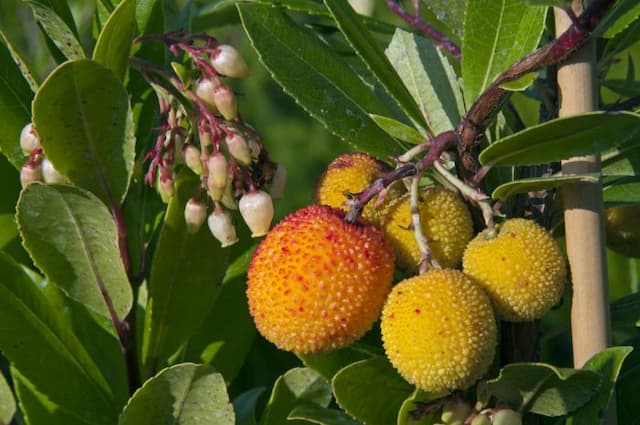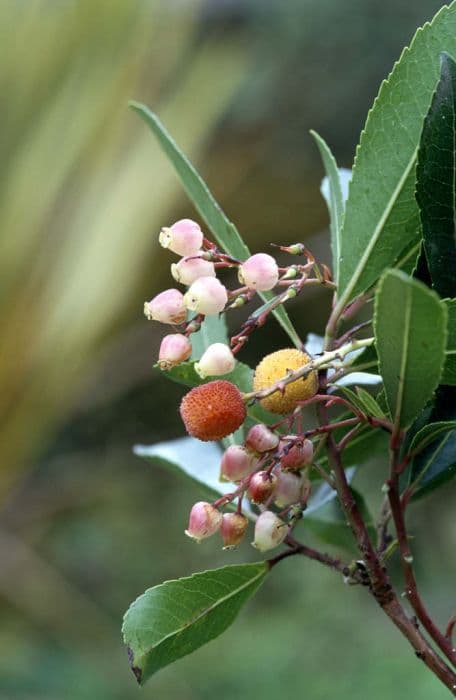Nine-pin Heath Erica mammosa

ABOUT
The plant known as Ninepin Heath is adorned with peculiarities that make it easily recognizable. The most striking feature of this plant is its multitude of densely clustered bell-shaped flowers, which range in color from pink to deep red. These flowers dangle elegantly from the tips of the branches and are designed to attract pollinators. The plant's leaves are needle-like and very small, giving it a fine, delicate texture. They are arranged in a way that forms tufts around the stems, creating a feathery appearance. The plant's overall shape tends to be bushy and well-branched, giving it a full and lush look. With its unique floral arrangement and needle-like foliage, the Ninepin Heath is a noteworthy specimen in any landscape where it is grown.
About this plant
 Names
NamesFamily
Ericaceae
Synonyms
Nine-Pins, Pink Cup, Pink Heath
Common names
Erica mammosa.
 Toxicity
ToxicityTo humans
The Erica mammosa, commonly known as the Nine-pin Heath, is not typically known for being poisonous to humans. There is limited information on the toxicity of this particular species to humans if ingested. As with many plants not commonly used for food, it is advisable to avoid ingesting this plant due to the risk of potential but undocumented toxicity, including gastrointestinal upset or allergic reactions.
To pets
Similar to its effects on humans, the Nine-pin Heath is not commonly known to be toxic to pets. However, the lack of documented toxicity does not guarantee safety, and it is generally recommended to prevent pets from ingesting this or any non-food plants to avoid possible gastrointestinal or allergic reactions. If a pet is suspected to have ingested any part of the plant and exhibits unusual symptoms, it is important to consult a veterinarian.
 Characteristics
CharacteristicsLife cycle
Perennials
Foliage type
Evergreen
Color of leaves
Green
Flower color
Pink
Height
3-5 feet (0.9-1.5 meters)
Spread
2-3 feet (0.6-0.9 meters)
Plant type
Shrub
Hardiness zones
9
Native area
South Africa
Benefits
 General Benefits
General Benefits- Ornamental Appeal: Erica mammosa, commonly known as the Nodding Heath, is prized for its attractive flowers and evergreen foliage, which add year-round beauty to gardens and landscapes.
- Wildlife Attraction: Its flowers provide nectar for bees and other pollinating insects, making it valuable for supporting local ecosystems.
- Drought Tolerance: Adapted to survive in dry conditions, Nodding Heath is ideal for water-wise gardens and reduces the need for irrigation.
- Soil Erosion Control: The root system of Erica mammosa helps to stabilize soil, particularly on slopes, aiding in the prevention of erosion.
- Low Maintenance: Once established, this plant requires minimal care, making it a convenient choice for gardeners with limited time or those new to gardening.
- Seasonal Interest: Nodding Heath typically blooms during winter, providing color and interest during a time when many other plants are dormant.
- Versatility: Suitable for a variety of garden styles including rock gardens, borders, and as ground cover, enhancing the diversity of landscaping designs.
- Adaptable to Various Climates: It can thrive in a range of climates, making it accessible to gardeners in many different regions.
 Medical Properties
Medical Properties- This plant is not used for medical purposes.
 Air-purifying Qualities
Air-purifying QualitiesThis plant is not specifically known for air purifying qualities.
 Other Uses
Other Uses- Decorative arts: The unique blossoms of Erica mammosa are often used in dry floral arrangements due to their long-lasting nature and striking appearance.
- Symbolism: The plant is sometimes used in bouquets or floral displays to symbolize solitude or beauty that thrives in harsh conditions, reflecting the plant's native growth in rocky soils.
- Erosion control: Erica mammosa, with its extensive root system, can be planted on slopes or in areas prone to soil erosion to help stabilize the ground.
- Privacy screens: Due to its dense growth, it can be used to create natural privacy screens in gardens or along property lines.
- Education: Botanical gardens and universities sometimes use Erica mammosa as a teaching tool to illustrate the diversity within the Ericaceae family.
- Beekeeping: The flowers of Erica mammosa are attractive to bees, making it a suitable plant for gardeners looking to support bee populations.
- Landscape design: The plant is used in landscape designs that focus on creating winter interest since it typically flowers in late winter to early spring.
- Thematic gardens: Erica mammosa is sometimes included in African-themed gardens due to its origin in South Africa.
- Crafts: The woody stems of the dead plant can be used in crafting, for example, in the making of small trinkets or as part of ornamental designs.
- Culinary decoration: While not edible, the flowers can be used as non-toxic decorative elements on plates or serving trays at high-end restaurants.
Interesting Facts
 Feng Shui
Feng ShuiThe plant is not used in Feng Shui practice.
 Zodiac Sign Compitability
Zodiac Sign CompitabilityThe plant is not used in astrology practice.
 Plant Symbolism
Plant Symbolism- Endurance: Erica mammosa, commonly known as Nine-pin Heath, often symbolizes endurance due to its ability to grow in challenging environments and withstand adverse conditions.
- Purity: The clean, elegant form of the Nine-pin Heath can represent purity, reflecting the simplicity and innocence associated with the plant.
- Solitude: As a plant that thrives in remote areas, Nine-pin Heath may embody solitude and the idea of finding strength and growth in solitude.
- Protection: Traditionally, Erica species have been associated with protection, and Nine-pin Heath continues this symbolism, offering shelter and sustenance to various forms of wildlife.
 Water
WaterNine-pin heath needs regular watering during its growing season, typically in the spring and summer months. Aim to keep the soil consistently moist but not waterlogged. Water the plant every week with about 1 to 2 gallons of water, depending on the size of the plant and the environmental conditions. During the winter months, reduce watering to every other week, ensuring that the top inch of soil has dried out before adding more water. Over-watering can lead to root rot, so it's essential to ensure good drainage and prevent standing water.
 Light
LightNine-pin heath thrives best in full sun to partial shade. It should be placed in a spot where it can receive at least four to six hours of direct sunlight daily. If grown indoors, it should be near a bright window with ample light, but if the light is too intense, such as in a south-facing window, consider using a sheer curtain to diffuse the sunlight. Avoid deep shade as it can lead to poor flowering and a leggy growth habit.
 Temperature
TemperatureNine-pin heath prefers cool to moderate temperatures, with ideal conditions being between 50 to 70 degrees Fahrenheit. It can tolerate minimum temperatures down to 30 degrees Fahrenheit but should be protected from hard frosts. Conversely, it can also survive in temperatures up to 80 degrees Fahrenheit, but it's important to ensure adequate moisture and ventilation to prevent stress from heat. Keeping Nine-pin heath in the ideal temperature range promotes healthy growth and flowering.
 Pruning
PruningNine-pin heath benefits from light pruning to maintain its shape and promote bushier growth. Prune the plant immediately after it has finished flowering, typically in the late spring or early summer. Remove dead or damaged branches, and lightly trim the tips to encourage new growth. Pruning can be done annually, but avoid cutting into old wood as it may not produce new shoots.
 Cleaning
CleaningAs needed
 Soil
SoilNodding Heath thrives in well-drained, acidic soil with a pH range of 5.0 to 6.0. The best soil mix is a blend of peat, sand, and fine pine bark, ensuring good aeration and moisture retention. Adding sulfur can help to lower the pH if needed.
 Repotting
RepottingNodding Heath requires repotting every two to three years to refresh the soil and prevent root crowding. This routine helps maintain its optimal health and encourages flowering.
 Humidity & Misting
Humidity & MistingNodding Heath prefers moderate to high humidity levels, around 50-60%. Avoid placing it in excessively dry environments to maintain the best health and flowering potential.
 Suitable locations
Suitable locationsIndoor
Place Nodding Heath in bright, indirect light inside and ensure high humidity.
Outdoor
Plant Nodding Heath in acidic soil; partial sun or light shade; protect from harsh winds.
Hardiness zone
7-9 USDA
 Life cycle
Life cycleErica mammosa, commonly known as Nine-pin Heath, begins its life cycle with the germination of seeds, which requires a fire-dependent ecosystem to break dormancy. After germination, the seedling stage involves root and shoot development as it establishes itself in the soil. The plant then enters a vegetative growth phase, where it develops a woody base and needle-like leaves, a characteristic of many Ericaceae family members. Over time, Nine-pin Heath progresses to the reproductive stage, producing distinct pink to red flowers that attract pollinators and ensure cross-pollination. After pollination, the flowers develop into fruit capsules containing seeds, which are eventually released back into the environment to continue the cycle. The mature plant may also undergo vegetative propagation through layering.
 Propogation
PropogationPropogation time
Spring to summer
The common name for Erica mammosa is Nine-pin Heath, and its most popular method of propagation is by seed. To propagate Nine-pin Heath, the ideal time is during spring or early summer, when temperatures are warm and conducive to germination. Seeds should be sown on the surface of a well-drained seed starting mix, as they require light to germinate. The soil surface must be kept consistently moist, but not waterlogged, and placed in a bright location without direct sunlight. It typically takes one to three months for germination to occur. Once seedlings have developed a couple of true leaves, they can be carefully transplanted to individual pots and grown on until they are strong enough to be planted outside in their final position.









